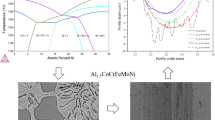Abstract
The deleterious effect of sulphur contamination on oxide spallation has been well demonstrated experimentally. The present paper attempts to account for this using finite-element modelling of crack growth along a sulphur-contaminated interface during cooling. Sulphur reduces the intrinsic work of adhesion, Wad, of this interface and, it is suggested, this is equivalent to reducing the characteristic fracture stress for that interface. It is shown that this approach does predict the typical trends in S-bearing alloys of spallation after shorter exposure times. A significant result is that the effective fracture energy for spallation, γeff, reduces with increasing sulphur contamination but is always 1–2 orders of magnitude larger than Wad. This high value for γeff arises because of creep relaxation within the alloy. Sulphur does not affect this process directly but reduces the extent of creep relaxation in a cooling transient by initiating spallation at a smaller value of temperature drop.






Similar content being viewed by others
References
A. W. Funkenbusch, J. W. Smeggil and N. S. Bornstein, Metallurgical Transactions 16A, 1985 (1164).
I. Melar and D. G. Lees, Materials Science and Technology 4, 1988 (455).
P. Fox, D. G. Lees and G. W. Lorimer, Oxidation of Metals 36, 1991 (491).
P. Y. Hou and J. Stringer, Oxidation of Metals 38, 1992 (323).
W. Y. Lee, Y. Zhang, I. G. Wright, B. A. Pint and P. K. Liaw, Metallurgical and Materials Transactions 29, 1998 (833).
L. Rivoaland, V. Maurice, P. Josso, M. P. Bacos and P. Marcos, Oxidation of Metals 60, 2008 (137).
P. Y. Hou, Annual Review of Materials Research 38, 2008 (275).
D. Naumenko, W. J. Quadakkers, V. Guttmann, et al., in Lifetime Modelling of High Temperature Corrosion Processes, eds. M. Schütze, et al. (Maney Publishing, London, 2001), pp. 66–82.
H. Al-Badairy, D. Naumenko, J. LeCoze, G. J. Tatlock and W. J. Quadakkers, Materials at High Temperatures 20, 2003 (405).
A. Strawbridge, H. E. Evans and C. B. Ponton, Materials Science Forum 251–254, 1997 (365).
B. Gleeson and M. A. Harper, in Lifetime Modelling of High Temperature Corrosion Processes, eds. M. Schütze, et al. (Maney Publishing, London, 2001), pp. 167–177.
K. L. Luthra and C. L. Briant, Oxidation of Metals 26, 1986 (397).
I. Rouzou, R. Molins, L. Rémy and F. Jomard, Materials Science Forum 461–464, 2004 (101).
E. Fedorova, D. Monceau and D. Oquab, Corrosion Science 52, 2010 (3932).
J. L. Smialek, Metallurgical Transactions 22A, 1991 (739).
J. L. Smialek, D. T. Jayne, J. C. Schaeffer and W. H. Murphy, Thin Solid Films 253, 1994 (285).
G. H. Meier, F. S. Pettit and J. L. Smialek, Werkstoffe und Korrosion 46, 1995 (1).
P. Y. Hou, Oxidation of Metals 52, 1999 (337).
X. Han, Y. Zhang and H. Xu, Chemical Physics Letters 378, 2003 (269).
I. J. Bennett, J. M. Kranenburg and W. G. Sloof, Journal of the American Ceramic Society 88, 2005 (2209).
E. A. A. Jarvis, A. Christensen and E. A. Carter, Surface Science 487, 2001 (55).
K. M. Carling and E. A. Carter, Acta Materialia 55, 2007 (2791).
Y. Jiang, J. R. Smith and A. G. Evans, Applied Physics Letters 92, 2008 (141918).
S. J. Bull, Tribology International 30, 1997 (491).
J. Mougin, M. Dupeux, A. Galerie and L. Antoni, Materials Science and Technology 18, 2002 (1217).
J. Mougin, M. Dupeux, L. Antoni and A. Galerie, Materials Science and Engineering A359, 2003 (44).
A. Galerie, F. Toscan, E. N’Dah, K. Przybylski, Y. Wouters and M. Dupeux, Materials Science Forum 461–464, 2004 (631).
Y. F. Liu, F. Kagawa and A. G. Evans, Acta Materialia 56, 2008 (43).
H. E. Evans, Materials Science and Technology 4, 1988 (415).
K. Bouhanek, D. Oquab and B. Pieraggi, Materials Science Forum 251–254, 1997 (33).
S. Baleix, G. Bernhart and P. Lours, Materials Science Forum 369–372, 2001 (539).
H. E. Evans, S. Osgerby and S. R. J. Saunders, in John Stringer Symposium on High Temperature Corrosion, eds. P. F. Tortorelli, et al. (ASM International, Materials Park, 2003), pp. 122–130.
H. E. Evans, A. Strawbridge, R. A. Carolan and C. B. Ponton, Materials Science and Engineering A225, 1997 (1).
H. E. Evans and M. P. Taylor, Surface and Coatings Technology 94–95, 1997 (27).
C. Sarioglu, M. J. Stiger, J. R. Blachere, R. Janakiraman, E. Schumann, A. Ashary, F. S. Pettit and G. H. Meier, Materials and Corrosion 51, 2000 (358).
V. Kolarik, H. Fietzek, M. Juez-Lorenzo and M. Groß, Materials Science Forum 369–372, 2001 (547).
S. Gray, K. Berriche-Bouhanek and H. E. Evans, Materials Science Forum 461–464, 2004 (755).
V. K. Tolpygo, J. R. Dryden and D. R. Clarke, Acta Materialia 46, 1998 (927).
U. R. Evans, An Introduction to Metallic Corrosion, (Edward Arnold Publishers, London, 1948), pp. 194–195.
H. E. Evans and R. C. Lobb, Corrosion Science 24, 1984 (209).
H. E. Evans, G. P. Mitchell, R. C. Lobb and D. R. J. Owen, Proceedings of the Royal Society of London 440, 1993 (1).
S. Osgerby, K. Berriche-Bouhanek and H. E. Evans, Materials Science and Engineering A412, 2005 (182).
J. M. A. Cesar de Sa, and D. R. J. Owen, Computer Aided Modelling of Grain Boundary Failure Mechanisms, Report Number C/R449/83, Department of Civil Engineering, University College Swansea, UK (1983).
P. Y. Hou and K. Priimak, Oxidation of Metals 63, 2005 (113).
H. Hindum and D. P. Whittle, Oxidation of Metals 18, 1983 (245).
Author information
Authors and Affiliations
Corresponding author
Rights and permissions
About this article
Cite this article
Evans, H.E. Predicting Oxide Spallation from Sulphur-Contaminated Oxide/Metal Interfaces. Oxid Met 79, 3–14 (2013). https://doi.org/10.1007/s11085-012-9322-6
Received:
Published:
Issue Date:
DOI: https://doi.org/10.1007/s11085-012-9322-6




